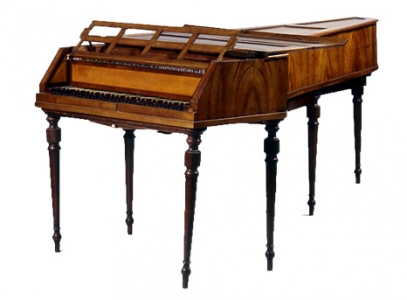The tangent piano
Tangent piano by Späth & Schmahl, Regensburg 1801
Bad Krozingen, collection Neumeyer-Junghanns-Tracey
The tangent piano offered a serious alternative to harpsichord or piano in the 1770s. The strings were struck like in a piano, but by "tangents", movable wooden slips, not unlike harpsichord jacks. By different stops the sound could appear rather harpsichord-like, but also like a piano and including tis expressive capabilities. The tangent piano slowly went out of fashion after 1800.
music sample:
(excerpt) Carl Philipp Emanuel Bach:
12 Variations (on "Les folies d'Espagne"), Wq 118-6
played by Rolf Junghanns on the Späth & Schmahl tangent piano, Bad Krozingen
The tangent piano was - in 1770 - a rather ingenious invention: It united in one the important elements of the traditional keyboard instruments clavichord and harpsichord and the new piano. A wooden tangent similar to a clavichord's, loose like a harpsichord jack and not unlike one in shape, struck the strings like a piano hammer. The sound was bright and rich of overtones like a harpsichord's, but could also sound like a piano with the moderator stop. The touch was comparable to a harpsichord's but dynamically flexible like a clavichord and piano united.
Animation of the mechanism of a tangent piano:
The instrument would have been a serious alternative to all other stringed keyboard instruments and rather popular, in southern Germany and wherever Regensburg instruments were exported to. Mozart and in all likeliness more of his contemporaries knew and esteemed it and many keyboard compositions with dynamic marks might have been composed not (only) with the piano but the tangent piano in mind.
Why not the tangent piano but the ordinary piano succeded on the long term, is not easy to decide. Obviosuly only a limited number of workshops produced any; maybe the inventors Franz Jacob Späth (1714-1786) and Christoph Friedrich Schmahl (1739-1814) were a bit too secretive and therefore had not that many followers or successors particularly abroad. There are also known only a few models of the space-saving "square" or upright variants with tangent action - and all the square and upright grands had a rather important part in popularizing the piano. Nonetheless the tangent piano played an important role within the multitude of keyboard models between 1770 and 1800.
© Greifenberger Institut für Musikinstrumentenkunde | info@greifenberger-institut.de




